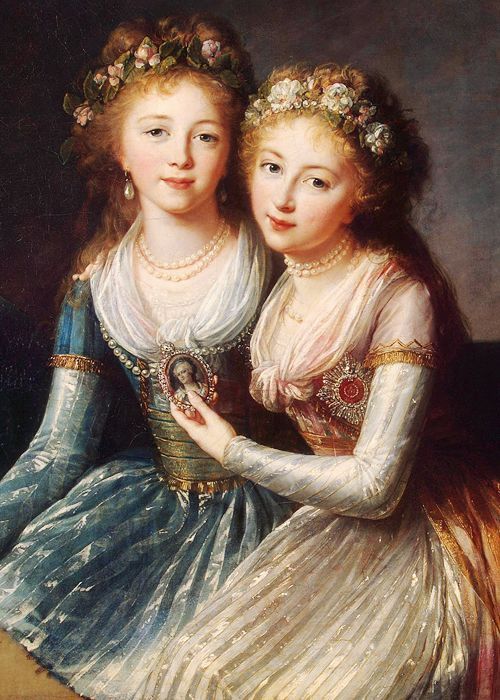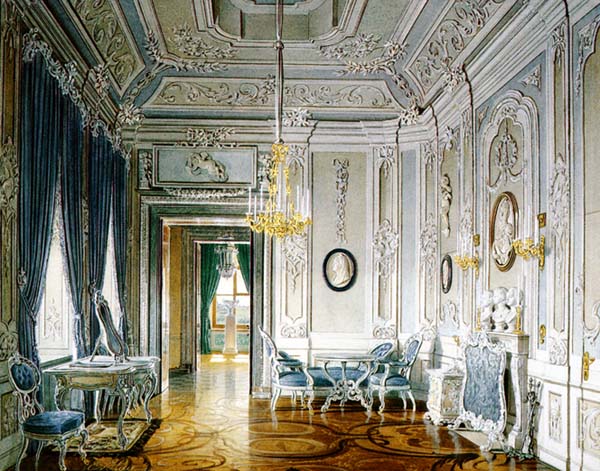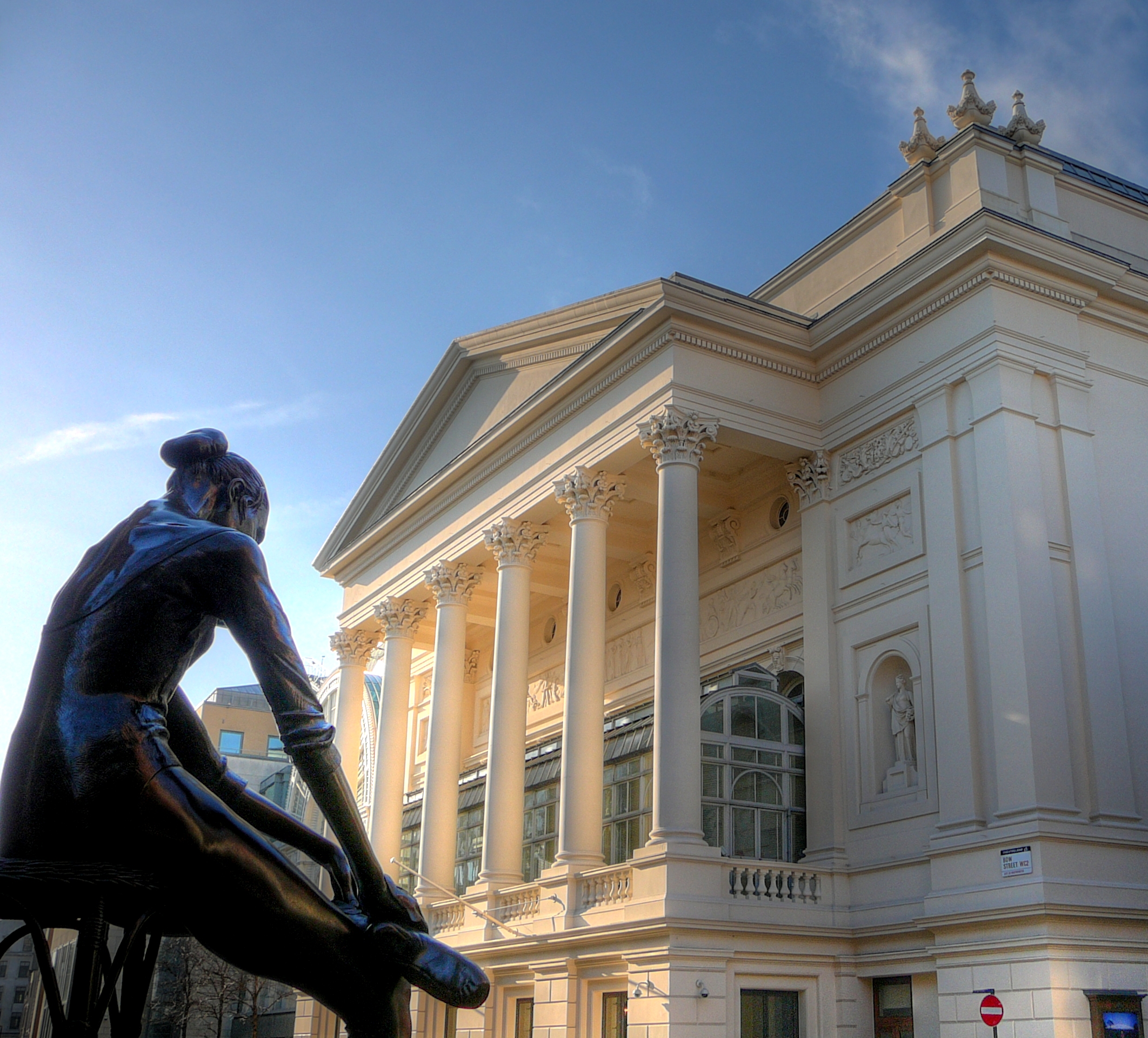|
Elena Pavlovna
Elena Pavlovna (; – ) was a grand duchess of Russia as the daughter of Paul I, the Russian emperor, and later became the Hereditary Princess of Mecklenburg-Schwerin as the wife of the Hereditary Prince Frederick Louis (1778–1819), who later become Hereditary Grand Duke. Early life Grand Duchess Elena Pavlovna Romanova was born in Saint Petersburg in the Russian Empire as the fourth child and second daughter of Tsesarevich Paul Petrovich of Russia (1754–1801) and his second wife, Tsesarevna Maria Feodorovna, born Duchess Sophie Dorothea of Württemberg (1759–1828). Out of her nine siblings, Elena was closest to her elder sister Alexandra Pavlovna, whom their paternal grandmother Catherine the Great compared unfavourably to Elena. At the age of six months, Elena was deemed smarter and more charming than her two-year-old sister Alexandra. However, as the sisters matured, Catherine loved both of them equally. Elena was educated privately at home, for the first year ... [...More Info...] [...Related Items...] OR: [Wikipedia] [Google] [Baidu] |
Vladimir Borovikovsky
Vladimir Lukich Borovikovsky ( – ) was a Russian artist of Ukrainian Cossack origin. He served at the court of Catherine the Great and dominated portraiture in Russia at the turn of the 19th century. Biography Vladimir Borovikovsky was born in Mirgorod, Cossack Hetmanate, Russian Empire (now Ukraine) on July 24, 1757 into a family of Ukrainian Cossack origin. His father, Luka Borovik, was an icon-painter. According to the family tradition, all four of Borovik's sons served as Cossacks in Mirgorod regiment, but Vladimir retired early at the rank of poruchik and devoted his life to art — mostly icon painting for local churches. Borovikovsky lived in Mirgorod until 1788, where he painted icons and portraits in the Cossack Baroque tradition. His friend Vasily Kapnist was preparing an accommodation for Empress Catherine II in Kremenchuk during her travel to newly conquered Crimea. Kapnist asked Borovikovsky to paint two allegoric paintings (Peter I of Russia and Catherine ... [...More Info...] [...Related Items...] OR: [Wikipedia] [Google] [Baidu] |
Alexandra And Elena Pavlovna Of Russia By E
Alexandra () is a female given name of Greek origin. It is the first attested form of its variants, including Alexander (, ). Etymologically, the name is a compound of the Greek verb (; meaning 'to defend') and (; GEN , ; meaning 'man'). Thus it may be roughly translated as "defender of man" or "protector of man". The name Alexandra was one of the epithets given to the Greek goddess Hera and as such is usually taken to mean "one who comes to save warriors". The earliest attested form of the name is the Mycenaean Greek ( or //), written in the Linear B syllabic script.Tablet MY V 659 (61). Alexandra and its masculine equivalent, Alexander, are both common names in Greece as well as countries where Germanic, Romance, and Slavic languages are spoken. Variants * Alejandra, Alejandrina (diminutive) (Spanish) * Aleksandra (Александра) (Albanian, Bulgarian, Estonian, Latvian, Lithuanian, Macedonian, Polish, Russian, Serbo-Croatian) * Alessandra (Italian) * Aless ... [...More Info...] [...Related Items...] OR: [Wikipedia] [Google] [Baidu] |
Gatchina Palace
The Great Gatchina Palace () is a palace in Gatchina, Leningrad Oblast, Russia. It was built from 1766 to 1781 by Antonio Rinaldi (architect), Antonio Rinaldi for Count Grigori Grigoryevich Orlov, who was a favourite of Catherine the Great, in Gatchina, a suburb of the royal capital Saint Petersburg. The Gatchina Palace combines classical architecture and themes of a medieval castle with ornate interiors typical of Russian classicism, located on a hill in central Gatchina next to Lake Serebryany. The Gatchina Palace became one of the favourite residences of the Russian Imperial Family, and during the 19th century was an important site of Russian politics. Since the February Revolution of 1917, February Revolution in 1917, it has been a museum and public park, and received UNESCO World Heritage Site status in 1990. History Imperial era In 1765, Catherine the Great, the Empress of the Russian Empire, purchased from Prince Boris Kurakin the Gatchina Manor, a small Manorialism, ma ... [...More Info...] [...Related Items...] OR: [Wikipedia] [Google] [Baidu] |
Princess Louise Of Saxe-Gotha-Altenburg (1756–1808)
Louise of Saxe-Gotha-Altenburg (; 9 March 1756 – 1 January 1808) was Duchess of Mecklenburg-Schwerin through her marriage to Grand Duke Frederick Francis I. Life Louise was the fourth and youngest child of Prince John August of Saxe-Gotha-Altenburg and Countess Louise Reuss of Schleiz. After the death of her mother in 1773, both she and her older sister Augusta inherited the title of co-Countess of Limpurg-Gaildorf as one of the several heirs of William Henry, Schenk of Limpurg zu Gaildorf (d. 1690 without surviving male issue).The Limpurg Inheritance in: heraldica.org etrieved 17 August 2016 Both sisters retained their portions of the Limpurg-Gaildorf inheritance (1/4 of Amt Gaildorf an ... [...More Info...] [...Related Items...] OR: [Wikipedia] [Google] [Baidu] |
Friedrich Franz I, Grand Duke Of Mecklenburg-Schwerin
Frederick Francis I (10 December 1756 – 1 February 1837) ruled over the German state of Mecklenburg-Schwerin, first as Duke from 1785 to 1815, and then as Grand Duke from 1815 until his death in 1837. Early life Frederick Francis I was born in Schwerin, Duchy of Mecklenburg-Schwerin, on 10 December 1756. He was the son of Duke Louis of Mecklenburg-Schwerin and Princess Charlotte Sophie of Saxe-Coburg-Saalfeld. His paternal grandparents were Christian Ludwig II, Duke of Mecklenburg-Schwerin (son of Frederick, Duke of Mecklenburg-Grabow) and Duchess Gustave Caroline of Mecklenburg-Strelitz (daughter of Adolphus Frederick II, Duke of Mecklenburg-Strelitz). His maternal grandparents were Franz Josias, Duke of Saxe-Coburg-Saalfeld and Princess Anna Sophie of Schwarzburg-Rudolstadt. Career In 1785, Friedrich Franz succeeded his uncle Frederick II as Duke of Mecklenburg-Schwerin. Following the Napoleonic Wars, Friedrich Franz was raised to the dignity of Grand Duke at the Congre ... [...More Info...] [...Related Items...] OR: [Wikipedia] [Google] [Baidu] |
Duchy Of Mecklenburg-Schwerin
The Duchy of Mecklenburg-Schwerin () was a duchy in northern Germany created in 1701, when Frederick William and Adolphus Frederick II divided the Duchy of Mecklenburg between Schwerin and Strelitz. Ruled by the successors of the Nikloting House of Mecklenburg, Mecklenburg-Schwerin remained a state of the Holy Roman Empire along the Baltic Sea littoral between Holstein-Glückstadt and the Duchy of Pomerania. Origins The dynasty's progenitor, Niklot (1090–1160), was a chief of the Slavic Obotrite tribal federation, who fought against the advancing Saxons and was finally defeated in 1160 by Henry the Lion in the course of the Wendish Crusade. Niklot's son, Pribislav, submitted to Henry, and in 1167 came into his paternal inheritance as the first Prince of Mecklenburg. After various divisions of territory among Pribislav's descendants, Henry II of Mecklenburg (1266–1329) by 1312 had acquired the lordships of Stargard and Rostock, and bequeathed the reunified Mecklenbur ... [...More Info...] [...Related Items...] OR: [Wikipedia] [Google] [Baidu] |
Music
Music is the arrangement of sound to create some combination of Musical form, form, harmony, melody, rhythm, or otherwise Musical expression, expressive content. Music is generally agreed to be a cultural universal that is present in all human societies. Definitions of music vary widely in substance and approach. While scholars agree that music is defined by a small number of elements of music, specific elements, there is no consensus as to what these necessary elements are. Music is often characterized as a highly versatile medium for expressing human creativity. Diverse activities are involved in the creation of music, and are often divided into categories of musical composition, composition, musical improvisation, improvisation, and performance. Music may be performed using a wide variety of musical instruments, including the human voice. It can also be composed, sequenced, or otherwise produced to be indirectly played mechanically or electronically, such as via a music box ... [...More Info...] [...Related Items...] OR: [Wikipedia] [Google] [Baidu] |
Literature
Literature is any collection of Writing, written work, but it is also used more narrowly for writings specifically considered to be an art form, especially novels, Play (theatre), plays, and poetry, poems. It includes both print and Electronic literature, digital writing. In recent centuries, the definition has expanded to include oral literature, much of which has been transcribed.; see also Homer. Literature is a method of recording, preserving, and transmitting knowledge and entertainment. It can also have a social, psychological, spiritual, or political role. Literary criticism is one of the oldest academic disciplines, and is concerned with the literary merit or intellectual significance of specific texts. The study of books and other texts as artifacts or traditions is instead encompassed by textual criticism or the history of the book. "Literature", as an art form, is sometimes used synonymously with literary fiction, fiction written with the goal of artistic merit, but ... [...More Info...] [...Related Items...] OR: [Wikipedia] [Google] [Baidu] |
Fine Art
In European academic traditions, fine art (or, fine arts) is made primarily for aesthetics or creative expression, distinguishing it from popular art, decorative art or applied art, which also either serve some practical function (such as pottery or most metalwork) or is generally of limited artistic quality in order to appeal to the masses. In the aesthetic theories developed in the Italian Renaissance, the highest art was that which allowed the full expression and display of the artist's imagination, unrestricted by any of the practical considerations involved in, say, making and decorating a teapot. It was also considered important that making the artwork did not involve dividing the work between different individuals with specialized skills, as might be necessary with a piece of furniture, for example. Even within the fine arts, there was a hierarchy of genres based on the amount of creative imagination required, with history painting placed higher than still life. ... [...More Info...] [...Related Items...] OR: [Wikipedia] [Google] [Baidu] |
Evgeny Karnovich
Evgeny Petrovich Karnovich (; 15 November 1823 – 6 November 1885) was Russian writer, historian, journalist and editor. Biography Born in rural Yaroslavl region into an affluent Ukrainian noble Karnovich family, Evgeny started his literary career in the 1840s as a translator of Aristophanes' comedies and a poet, while working as a teacher, then a minor state official. Several years later he moved to Vilno, to become the head of the local Archeologist committee. In 1859, after retirement, Karnovich became a professional journalist, writing on the subjects of history, politics, social issues and jurisprudence, as well as publishing his own poems and stories. In 1858–1861 he was the head of the Contemporary Review section ''Sovremennik'', in 1865–1871, one of the leading figures in the '' Golos'' newspaper staff. He published the weekly magazine ''Mirovoi Posrednik'' (People's Attorney, 1861–1862), edited '' Birzhevyie Vedomosti'' (Stock Exchange News, 1875–1876) and ''Ot ... [...More Info...] [...Related Items...] OR: [Wikipedia] [Google] [Baidu] |
Catherine The Great
Catherine II. (born Princess Sophie of Anhalt-Zerbst; 2 May 172917 November 1796), most commonly known as Catherine the Great, was the reigning empress of Russia from 1762 to 1796. She came to power after overthrowing her husband, Peter III. Under her long reign, inspired by the ideas of the Enlightenment, Russia experienced a renaissance of culture and sciences, which led to the founding of many new cities, universities, and theatres, along with large-scale immigration from the rest of Europe and the recognition of Russia as one of the great powers of Europe. In her accession to power and her rule of the empire, Catherine often relied on her noble favourites, most notably Count Grigory Orlov and Grigory Potemkin. Assisted by highly successful generals such as Alexander Suvorov and Pyotr Rumyantsev, and admirals such as Samuel Greig and Fyodor Ushakov, she governed at a time when the Russian Empire was expanding rapidly by conquest and diplomacy. In the south, the ... [...More Info...] [...Related Items...] OR: [Wikipedia] [Google] [Baidu] |
Grand Duchess Alexandra Pavlovna Of Russia
Grand Duchess Alexandra Pavlovna of Russia (: – ) was a daughter of Emperor Paul I of Russia and sister of emperors Alexander I of Russia, Alexander I and Nicholas I of Russia, Nicholas I. She married Archduke Archduke Joseph, Palatine of Hungary, Joseph of Austria, Palatine of Hungary. Her marriage was the only Romanov-Habsburg marital alliance to date. Birth Grand Duchess Alexandra Pavlovna was born in Tsarskoye Selo as the third child and eldest daughter of Tsesarevich Paul I of Russia, Paul and his second wife Sophie Dorothea of Württemberg (renamed Maria Feodorovna after her wedding). The gender of the child disappointed her paternal grandmother, Catherine the Great. She wrote: The Empress' secretary Alexander Khrapovitsky wrote that the Empress considered the newborn Grand Duchess Alexandra very ugly, especially compared with her older brothers.Evgeny Karnovich: ''Alexandra Pavlovna'' in: ''Remarkable and enigmatic personalities of the 17th and 19th centuries'', ed. ... [...More Info...] [...Related Items...] OR: [Wikipedia] [Google] [Baidu] |







